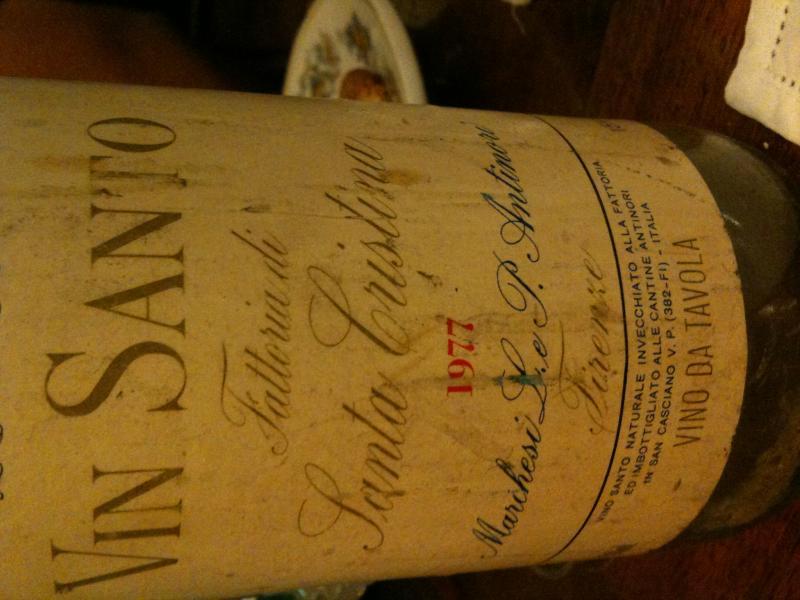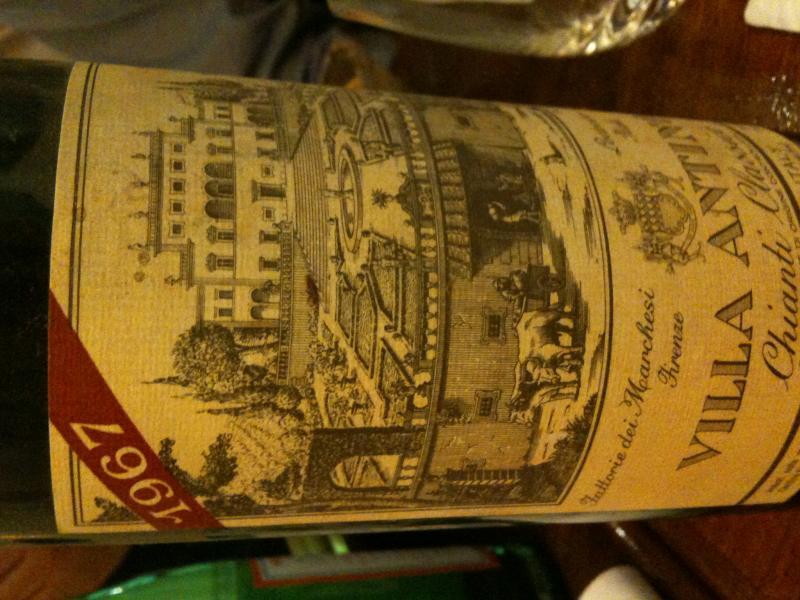
CommissionerLin
participating member-
Posts
74 -
Joined
-
Last visited
Contact Methods
-
Website URL
http://
-
I would recommend Cantinetta Antinori, Buca Lapi, Procacci and Osteria di Passignano - all Antinori-owned, all superb. Ate at all 4 establishments when I was there 2 weeks ago. Had an amazing bottle of Chianti Classico '67 at Cantinetta followed by a '77 Vin Santo (both by Antinori) at Cantinetta A. Now trying lamely to shed inches off my bistecca-enhanced waistline.
-
japanese snow crab (zhuhai kani) vinegar sauce
CommissionerLin replied to a topic in Japan: Cooking & Baking
Bingo!!! Thats the one. Thanks Cats2! Thanks Hiroyuki-san for providing the links to the actual recipes. Armed with the recipes, I made a sanbaizu and turned it into a tosazu and then into something else with a dash of bottled yuzu juice (kaori yuzu kaju). Trotted down to the local Japanese supermarket, no zuwai kani but there were 3 live King crabs (advertised as taraba kani from Alaska) that looked totally appealing. I picked one, averted my eyes as it was swiftly despatched, dismembered and saran wrapped in polystyrene trays. The legs were grilled on a robotayaki, dunked in the tosazu-mutant sauce, wolfed down and pronounced as amazingly delicious. Should have taken photos but I forgot. Only remembered after the legs had been devoured. Here's a picture of the shell with somen stirred in with the crab tomalley and garnished with coriander. Should have bought all 3 crabs. -
Do a batch of Oyster Tempura. Many recipes for this on the net. http://www.bbc.co.uk/food/recipes/database...chi_85286.shtml
-
Amaze your fellow diners with apoms... click here
-
I didn't catch the show but sounds like a Japanese mandolin to me... Click here And here
-
Here's a slow-cook recipe that I've used and modified over the years with much success. Slow Cooked Lamb Shanks (Ottoman/Greek - style) 1-1.5 kg lamb fore shank (4-5 pieces) ½ cup onions, coarsely chopped ½ cup capsicum, coarsely chopped ¼ cup olives (preferably green Kalamatta) 1½ cups plum, honey or cherry tomatoes, halved 6 cloves garlic, peeled and smashed 2-3 whole green chillies, seeds removed (optional) 1 punnet brown or white button mushrooms, quartered A sprinkling of Mediterranean herbs/herbs de Provence (oregano, rosemary, thyme, sage etc) ½ cup corn flour 1 cup Visado from Santorini or Vin Santo fromTuscany (if unavailable, substitute with any sweet white dessert wine, White Port or sweet sherry) 2-3 cups chicken or pork stock Method 1. Season lamb shanks with herbs, salt, pepper and a dash of EVOO. Coat with corn flour. 2. Refrigerate for 6-48 hours. 3. Bring lamb shanks to room temperature (around 24 - 26 deg C) either by resting on the kitchen counter or under a griller/salamander set at low heat. 4. Warm up oven at 180 deg C setting for 30-45 mins. 5. Brown shanks in vegetable or peanut oil under high heat, in a wok or skillet. 6. Place shanks on kitchen towels to drain oil. 7. Transfer shanks to a Dutch oven or cast iron pot with a tight-fitting lid. 8. Add all vegetable ingredients (except mushrooms), wine, stock and aromatics. The shanks do not have to be completely immersed in liquid. 50 per cent immersion is sufficient. 9. Place pot in oven with lid on. 10. Reduce oven setting to 120 deg C. Bake for 1 hour. 11. Remove from oven, rotate shanks to avoid uneven browning, baste shanks with liquid from the pot. 12. Replace pot in oven. Reduce oven setting to 110 deg C. Bake for another hour. 13. Repeat step 11. Add mushrooms. 14. Bake for another hour or until meat is fork tender and separates easily from the bone. 15. Ladle into bowls, and serve with Turkish bread, ciabatta or other flat bread, pilaf rice or pasta. I would add that this recipe is geared for foreshanks. If using hind shanks adjust proportions and cooking times accordingly. The corn flour should result in a nice thick gravy but if a thicker gravy is desired (for example if serving with pasta), ladle the gravy into a saucepan and reduce over the stovetop. Using a cast iron pot makes a great difference to the outcome. I have tried this recipe using various receptacles ranging from pyrex to clay but the most jubilant results have come from a cast iron pot.
-
I would recommend: Kahala for fusion Kaiseki - 8 seater so reservations are essential Ron for Teppanyaki Ando for Sushi - lunch only, queue at the door, they don't do reservations apparently.
-
How bout:- 1. Cold Japanese buckwheat soba to start, 2. Eggplant, potato and smoked fishhead curry, served with a slither of basmati rice 3. Goats cheese with honey and jellied quince ensconsed in a griddle cake 4. Rhubarb and pecan pie
-
The term covers a number of species of fish worlwide but in a North American context it most often refers to the the Goliath Grouper (Epinephelus itajara). In Australia its another name for the Mulloway (Argyrosomus hololepidotus Lacepede). I am not sure which fish was on the menu but it is quite unlikely to be the Goliath Grouper as it is a protected species in most countries. As the name suggests these fish can get quite big - exceeding the size of a VW Beetle. Do you recall the Spanish term for this fish in the menu?
-
kiwi Sav Blanc and goat's cheese - surely a marriage made in heaven like lamb and Aussie shiraz.
-
Good for you BarbaraY. Um... I get an impression from reading this thread that cooking rice without washing it first appears to be an option within contemplation. Much against my laissez-faire instincts, I can't resist delivering a tiny admondishment against this practice. Anyone who has been remotely involved in the farming, production or storage of rice will know that a major challenge in the production/storage logistics chain is keeping rodents and insects from coming into contact with the rice. In places where production and storage standards are less than fastidious, you can imagine that this goal is seldom met. Anyone who has watched "Fast Food Nation" can surely accept the notion that shoddy practices in food production can occur anywhere. Hygiene aside, even rice produced under the most stringent conditions still needs a wash - to remove the film of rice talc (and surely dust?) from the rice grains. Use calrose rice to up the stickiness quotient and use glutinous rice to really scale the pinnacle of stodginess. But not washing rice in order to make it stickier ought not be regarded as an acceptable option.
-
Try using short grain or calrose rice.
-
That variety of rice noodles typically doesn't need soaking and cooks in a jiffy. Toss the noodles into a pot of boiling water. The noodles are cooked when they change colour, typically 1-2 minutes depending on temperature, atmospheric pressure and the water to noodle ratio in the pot. Once the colour begins to change, toss the noodles into a colander and place it under cold running water. Rice noodles are invariably starchier than wheat based noodles and washing them gets rid of excess starch. I am not sure that you can ever coax this variety of noodles to a "semi-chewy state". If you're after a more al dente mouthfeel you might consider using Chinese rice noodles ("Hor Fun" in Cantonese) or Chinese egg noodles ("Mien" in Cantonese) which is made from wheat.
-
What to buy in Japan? Where? Knives? Else?
CommissionerLin replied to a topic in Japan: Cooking & Baking
Yeah, I'm really happy with the 1,000 yen knife I bought at Muji. Sharpest knife I've ever owned, which I suppose is not saying much. But now Prasantrin has championed Aritsugu, I'll have to check it out. Check out 100 yen shops for fun gadgets. There's a big Daiso in Harajuku, on the main shopping street, which has a large selection. ← I can second Prasantrin's advice re Aritsugu. I have a 10" deba and a 8" santoku bought at their main store in Nishiki last year. I use them in preference to every other knife in the cupboard. These knives are made of soft carbon steel and require a higher degree of care and maintenence than those made from stainless steel. If you plan to own one you need to invest some time in honing up your knife-sharpening skills. Well-sharpened Japanese knives are a real joy to use and this alone justifies the investment.


